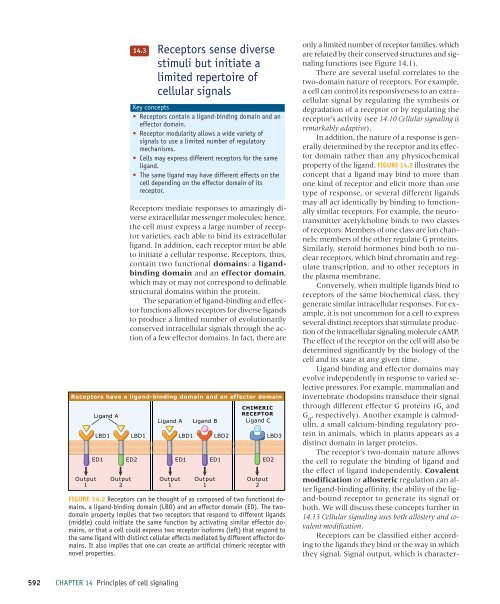Principles of cell signaling - UT Southwestern
Principles of cell signaling - UT Southwestern
Principles of cell signaling - UT Southwestern
Create successful ePaper yourself
Turn your PDF publications into a flip-book with our unique Google optimized e-Paper software.
39057_ch14_<strong>cell</strong>bio.qxd 8/28/06 5:11 PM Page 592<br />
Ligand A<br />
14.3<br />
Receptors sense diverse<br />
stimuli but initiate a<br />
limited repertoire <strong>of</strong><br />
<strong>cell</strong>ular signals<br />
Key concepts<br />
• Receptors contain a ligand-binding domain and an<br />
effector domain.<br />
• Receptor modularity allows a wide variety <strong>of</strong><br />
signals to use a limited number <strong>of</strong> regulatory<br />
mechanisms.<br />
• Cells may express different receptors for the same<br />
ligand.<br />
• The same ligand may have different effects on the<br />
<strong>cell</strong> depending on the effector domain <strong>of</strong> its<br />
receptor.<br />
Receptors mediate responses to amazingly diverse<br />
extra<strong>cell</strong>ular messenger molecules; hence,<br />
the <strong>cell</strong> must express a large number <strong>of</strong> receptor<br />
varieties, each able to bind its extra<strong>cell</strong>ular<br />
ligand. In addition, each receptor must be able<br />
to initiate a <strong>cell</strong>ular response. Receptors, thus,<br />
contain two functional domains: a ligandbinding<br />
domain and an effector domain,<br />
which may or may not correspond to definable<br />
structural domains within the protein.<br />
The separation <strong>of</strong> ligand-binding and effector<br />
functions allows receptors for diverse ligands<br />
to produce a limited number <strong>of</strong> evolutionarily<br />
conserved intra<strong>cell</strong>ular signals through the action<br />
<strong>of</strong> a few effector domains. In fact, there are<br />
Receptors have a ligand-binding domain and an effector domain<br />
Output<br />
1<br />
Output<br />
2<br />
Ligand A<br />
Output<br />
1<br />
Ligand B<br />
Output<br />
1<br />
CHIMERIC<br />
RECEPTOR<br />
Ligand C<br />
LBD1 LBD1 LBD1 LBD2 LBD3<br />
ED1 ED2<br />
ED1 ED1<br />
Output<br />
2<br />
ED2<br />
FIGURE 14.2 Receptors can be thought <strong>of</strong> as composed <strong>of</strong> two functional domains,<br />
a ligand-binding domain (LBD) and an effector domain (ED). The twodomain<br />
property implies that two receptors that respond to different ligands<br />
(middle) could initiate the same function by activating similar effector domains,<br />
or that a <strong>cell</strong> could express two receptor is<strong>of</strong>orms (left) that respond to<br />
the same ligand with distinct <strong>cell</strong>ular effects mediated by different effector domains.<br />
It also implies that one can create an artificial chimeric receptor with<br />
novel properties.<br />
only a limited number <strong>of</strong> receptor families, which<br />
are related by their conserved structures and <strong>signaling</strong><br />
functions (see Figure 14.1).<br />
There are several useful correlates to the<br />
two-domain nature <strong>of</strong> receptors. For example,<br />
a <strong>cell</strong> can control its responsiveness to an extra<strong>cell</strong>ular<br />
signal by regulating the synthesis or<br />
degradation <strong>of</strong> a receptor or by regulating the<br />
receptor’s activity (see 14.10 Cellular <strong>signaling</strong> is<br />
remarkably adaptive).<br />
In addition, the nature <strong>of</strong> a response is generally<br />
determined by the receptor and its effector<br />
domain rather than any physicochemical<br />
property <strong>of</strong> the ligand. FIGURE 14.2 illustrates the<br />
concept that a ligand may bind to more than<br />
one kind <strong>of</strong> receptor and elicit more than one<br />
type <strong>of</strong> response, or several different ligands<br />
may all act identically by binding to functionally<br />
similar receptors. For example, the neurotransmitter<br />
acetylcholine binds to two classes<br />
<strong>of</strong> receptors. Members <strong>of</strong> one class are ion channels;<br />
members <strong>of</strong> the other regulate G proteins.<br />
Similarly, steroid hormones bind both to nuclear<br />
receptors, which bind chromatin and regulate<br />
transcription, and to other receptors in<br />
the plasma membrane.<br />
Conversely, when multiple ligands bind to<br />
receptors <strong>of</strong> the same biochemical class, they<br />
generate similar intra<strong>cell</strong>ular responses. For example,<br />
it is not uncommon for a <strong>cell</strong> to express<br />
several distinct receptors that stimulate production<br />
<strong>of</strong> the intra<strong>cell</strong>ular <strong>signaling</strong> molecule cAMP.<br />
The effect <strong>of</strong> the receptor on the <strong>cell</strong> will also be<br />
determined significantly by the biology <strong>of</strong> the<br />
<strong>cell</strong> and its state at any given time.<br />
Ligand binding and effector domains may<br />
evolve independently in response to varied selective<br />
pressures. For example, mammalian and<br />
invertebrate rhodopsins transduce their signal<br />
through different effector G proteins (G t<br />
and<br />
G q<br />
, respectively). Another example is calmodulin,<br />
a small calcium-binding regulatory protein<br />
in animals, which in plants appears as a<br />
distinct domain in larger proteins.<br />
The receptor’s two-domain nature allows<br />
the <strong>cell</strong> to regulate the binding <strong>of</strong> ligand and<br />
the effect <strong>of</strong> ligand independently. Covalent<br />
modification or allosteric regulation can alter<br />
ligand-binding affinity, the ability <strong>of</strong> the ligand-bound<br />
receptor to generate its signal or<br />
both. We will discuss these concepts further in<br />
14.13 Cellular <strong>signaling</strong> uses both allostery and covalent<br />
modification.<br />
Receptors can be classified either according<br />
to the ligands they bind or the way in which<br />
they signal. Signal output, which is character-<br />
592 CHAPTER 14 <strong>Principles</strong> <strong>of</strong> <strong>cell</strong> <strong>signaling</strong>
















